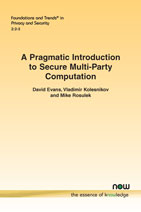A Pragmatic Introduction to Secure Multi-Party Computation
By David Evans, University of Virginia, USA, evans@virginia.edu | Vladimir Kolesnikov, Georgia Institute of Technology, USA, kolesnikov@gatech.edu | Mike Rosulek, Oregon State University, USA, rosulekm@eecs.oregonstate.edu
Abstract
Secure multi-party computation (MPC) has evolved from a theoretical curiosity in the 1980s to a tool for building real systems today. Over the past decade, MPC has been one of the most active research areas in both theoretical and applied cryptography. This article introduces several important MPC protocols, and surveys methods for improving the efficiency of privacy-preserving applications built using MPC. Besides giving a broad overview of the field and the insights of the main constructions, we overview the most currently active areas of MPC research and aim to give readers insights into what problems are practically solvable using MPC today and how different threat models and assumptions impact the practicality of different approaches.
A Pragmatic Introduction to Secure Multi-Party Computation
Since its introduction by Andrew Yao in the 1980s, multi-party computation has developed from a theoretical curiosity to an important tool for building large-scale privacy-preserving applications. Secure multi-party computation (MPC) enables a group to jointly perform a computation without disclosing any participant’s private inputs. The participants agree on a function to compute, and then can use an MPC protocol to jointly compute the output of that function on their secret inputs without revealing them.
This monograph provides an introduction to multi-party computation for practitioners interested in building privacy-preserving applications and researchers who want to work in the area. The authors introduce the foundations of MPC and describe the current state of the art. The goal is to enable readers to understand what is possible today, and what may be possible in the future. It provides a starting point for building applications using MPC and for developing MPC protocols, implementations, tools, and applications.
Those seeking a concise, accessible introduction to the topic which quickly enables them to build practical systems or conduct further research will find this essential reading.
